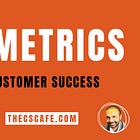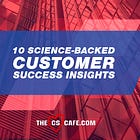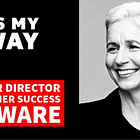How to Explain Customer Success Beyond SaaS: Practical Tips for All Industries
Are you finding it hard to explain customer success to someone who doesn't know much about the SaaS (Software as a Service) industry?
As technology and software services grow, it's key to share why customer success matters beyond the industry.
Let’s break down the basics of customer success and give practical tips for talking about it with others.
What Is Customer Success?
So first things first.
Customer Success is about actively helping customers reach their goals with a product or service.
Unlike reactive customer service, it's an ongoing effort to make sure customers get value over time.
This means offering support, resources, and guidance to not only solve problems but also improve the overall customer experience and build lasting relationships.
Why Is Customer Success Important for SaaS Companies?
Customer success is critically important for SaaS companies for several reasons, as it directly contributes to the overall success, growth, and sustainability of the business.
Here are key reasons why customer success is paramount for SaaS companies:
Subscription-Based Model:
Many SaaS companies operate on a subscription-based model where customers pay recurring fees for access to the software.
Success is not just about making a sale but ensuring that customers continue to find value in the product throughout their subscription.
Customer Success is key to retaining customers and maximizing the lifetime value of each customer.
Reducing Churn:
Customer churn (the rate at which customers stop using the product) is a significant concern for SaaS companies.
Effective customer success strategies help identify and address issues that might lead to churn, ultimately reducing customer turnover and preserving revenue.
Maximizing Customer Lifetime Value (CLV):
Customer success is instrumental in maximizing the lifetime value of customers. As they continue to ensure ongoing satisfaction and help customers achieve their goals, SaaS companies can build long-term relationships, leading to continued subscription renewals and potential upsell opportunities.
Enhancing Product Adoption:
Successful onboarding and ongoing engagement strategies contribute to higher product adoption rates. When customers understand and effectively use the software, they are more likely to renew their subscriptions and become advocates for the product.
Building Advocacy and Referrals:
Satisfied and successful customers become advocates for the SaaS company. They are more likely to recommend the software to others, leading to organic growth through positive word of mouth and referrals.
Competitive Differentiation:
In a crowded SaaS market, customer success becomes a key differentiator. Companies that prioritize customer success stand out by providing not just a product but a comprehensive solution that supports customers throughout their journey.
Proactive Issue Resolution:
Customer success involves proactive monitoring of customer health indicators and early identification of potential issues.
This proactive approach enables SaaS companies to address concerns before they escalate, reducing the number of support tickets and enhancing overall customer satisfaction.
Feedback for Product Improvement:
Customer success teams are in a prime position to collect valuable feedback from users.
This feedback is essential for driving continuous product improvement, ensuring that the software aligns with evolving customer needs and expectations.
Cross-Selling and Upselling Opportunities:
Satisfied customers are more receptive to additional features or upgrades. Customer success teams can identify opportunities for cross-selling and upselling, driving incremental revenue for the SaaS company.
Scalability and Sustainable Growth:
A focus on customer success is foundational for scalable and sustainable growth.
As SaaS companies acquire new customers, the ability to retain and expand relationships with existing customers becomes key for maintaining a healthy growth trajectory.
How Does Customer Success Differ from Customer Service?
Customer Success and Customer Service are related concepts, but they have distinct focuses and operate at different stages of the customer journey.
Here's how they differ:
Focus and Scope:
Customer Success: The primary focus of customer success is to ensure that customers achieve their desired outcomes and derive value from the product or service over the entire duration of their relationship with the company.
It involves proactive measures to enhance the customer experience, drive product adoption, and contribute to the customer's long-term success.
Customer Service: Customer service, on the other hand, is reactive and primarily deals with addressing customer issues, requests, and providing support when customers encounter problems or have questions.
It is often transactional and focuses on resolving immediate concerns.
Proactivity vs. Reactivity:
Customer Success: Customer success is proactive and involves anticipating and addressing potential issues before they become problems. It aims to guide customers toward success, offering assistance, resources, and guidance throughout their journey.
Customer Service: Customer service is reactive, responding to customer needs as they arise. It involves troubleshooting issues, answering queries, and providing solutions to problems raised by customers.
Timeline of Engagement:
Customer Success: The engagement in customer success is ongoing and extends throughout the entire customer lifecycle. It begins from the onboarding phase and continues as long as the customer is using the product or service.
Customer Service: Customer service engagements are typically transactional and occur when a customer reaches out for assistance. The interactions are often brief and focused on resolving the immediate concern.
Goal and Outcome:
Customer Success: The ultimate goal of customer success is to foster long-term customer relationships, drive customer satisfaction, and contribute to the overall success and growth of the customer. The outcome is a satisfied, loyal customer who continues to find value in the product or service.
Customer Service: The primary goal of customer service is to address and resolve specific issues or questions raised by the customer. The immediate outcome is the resolution of the problem at hand.
Metrics and Measurement:
Customer Success: Metrics in customer success often include customer satisfaction scores, Net Promoter Score (NPS), customer retention rates, and lifetime value. These metrics assess the overall health of the customer relationship.
Customer Service: Metrics in customer service may include response time, resolution time, first-call resolution, and customer service ticket volume. These metrics focus on the efficiency and effectiveness of issue resolution.
Ownership of Relationship:
Customer Success: Customer success is a shared responsibility involving various teams within the organization, including customer success managers, sales, marketing, and product development. It requires cross-functional collaboration to ensure the customer's success.
Customer Service: Customer service is often handled by a dedicated support team or customer service representatives. The focus is on addressing specific customer issues rather than overseeing the broader customer relationship.
What Are the Key Components of a Customer Success Strategy?
A successful customer success strategy involves a combination of proactive measures, ongoing engagement, and continuous improvement.
Here are key components to consider when developing a customer success strategy:
Customer Onboarding:
Ensure a smooth onboarding process to help customers get started with your product or service. Provide clear guidance, training, and resources to facilitate a positive initial experience.
Proactive Communication:
Establish regular communication channels to keep customers informed about updates, best practices, and relevant information. Proactive communication helps build a strong relationship and demonstrates a commitment to customer success.
Customer Education:
Offer educational resources, such as tutorials, webinars, documentation, and knowledge bases, to empower customers to use your product or service effectively.
Customer Education contributes to customer self-sufficiency and satisfaction.
Customer Health Monitoring:
Implement tools and processes to monitor customer health indicators, such as product usage, engagement metrics, and feedback.
Monitoring customer health allows for early identification of potential issues and the ability to intervene proactively.
Feedback Collection and Analysis:
Actively seek customer feedback through surveys, reviews, and other channels. Analyze this feedback to understand customer satisfaction, identify areas for improvement, and make data-driven decisions.
Customer Success Metrics:
Define and track key performance indicators (KPIs) related to customer success. Common metrics include Net Promoter Score (NPS), Customer Satisfaction (CSAT), churn rate, and customer lifetime value (LTV).
Customer Segmentation:
Segment your customer base based on characteristics such as needs, usage patterns, and demographics.
Tailor your customer success approach to the specific requirements of each segment to provide personalized support.
Customer Advocacy Programs:
Encourage satisfied customers to become advocates for your brand. Implement customer advocacy programs, referral initiatives, and case studies to showcase successful implementations and positive experiences.
Renewal Management (for Subscription Models):
If your business operates on a subscription model, establish effective renewal management practices.
Proactively engage with customers nearing the end of their subscription to ensure retention and explore opportunities for upselling.
Cross-Selling and Upselling:
Identify opportunities to provide additional value to customers through cross-selling and upselling.
This involves understanding customer needs and introducing them to relevant features, products, or services.
Customer Journey Mapping:
Map out the customer journey to understand touchpoints and potential pain points. This helps in designing targeted interventions to enhance the overall customer experience.
Continuous Improvement:
Foster a culture of continuous improvement within your organization.
Use customer feedback and data to refine your products, services, and customer success processes.
Customer Retention Strategies:
Develop strategies to reduce customer churn.
This may involve targeted interventions for at-risk customers, personalized retention offers, or improvements to address common reasons for customer turnover.
Team Collaboration:
Promote collaboration between customer success teams and other departments within the organization, such as sales, marketing, and product development.
Cross-functional collaboration ensures a holistic approach to customer success.
How Does Customer Success Impact Business Growth and Retention?
Customer success plays a key role in influencing both business growth and customer retention.
Here's how:
Increased Customer Retention:
Long-Term Relationships: Customer success is centered around building long-term relationships with customers. As you consistently deliver value and ensure customers achieve their goals, you can build loyalty and increase customer retention.
Reduced Churn: Churn, or customer turnover, is a significant concern for businesses. A robust customer success strategy addresses the factors that might lead to churn, such as dissatisfaction or unmet expectations, helping to retain more customers over time.
Positive Customer Experience:
Customer Satisfaction: Successful customer experiences lead to high levels of customer satisfaction. When customers are happy with the product or service and the overall experience, they are more likely to stay and continue their relationship with the business.
Word of Mouth and Referrals: Satisfied customers become advocates. They are more likely to recommend your business to others, leading to new customer acquisitions through positive word of mouth and referrals.
Maximized Customer Value:
Cross-Selling and Upselling Opportunities: A strong customer success strategy identifies opportunities to provide additional value to customers. This can include introducing them to new features, products, or services, leading to increased revenue through cross-selling and upselling.
Lifetime Value (LTV): Customer success contributes to maximizing the lifetime value of a customer. As you consistently deliver value and ensure ongoing satisfaction, customers become more likely to remain engaged and make repeat purchases over an extended period.
Reduced Support Costs:
Proactive Issue Resolution: A proactive approach to customer success involves identifying and resolving issues before they escalate. As you address concerns early on, you can reduce the need for extensive customer support, saving on support costs and resources.
Differentiation in the Market:
Competitive Advantage: Businesses that prioritize customer success often stand out in the market. Providing exceptional customer experiences can become a key differentiator, setting your business apart from competitors and attracting new customers.
Brand Reputation: A positive reputation for customer success contributes to the overall brand image. A strong brand reputation attracts new customers and enhances the overall perception of the business in the market.
Data-Driven Decision-Making:
Continuous Improvement: Customer success relies on gathering and analyzing customer feedback and data. As you leverage insights from customer interactions, you can make more informed decisions, identify areas for improvement, and enhance their offerings to better meet customer needs.
Adaptability to Customer Needs:
Scalable Growth: Businesses that adapt to evolving customer needs and preferences are better positioned for scalable growth. Customer success strategies that prioritize flexibility and responsiveness contribute to the adaptability required for sustained expansion.
What Are Some Examples of Successful Customer Success Strategies in SaaS?
Successful customer success strategies in SaaS focus on maximizing customer satisfaction, retention, and long-term value.
Here are some examples of effective customer success strategies in the SaaS industry:
Onboarding and Training Programs:
Implementing a robust onboarding process and providing training resources helps customers understand how to use the software effectively from the start. This reduces the learning curve and increases the likelihood of successful adoption.
Proactive Customer Support:
Offering proactive customer support means anticipating and addressing potential issues before they become problems. This can involve reaching out to customers to assist, share best practices, or inform them about new features.
Regular Check-ins and Reviews:
Establishing a cadence of regular check-ins and performance reviews helps maintain an open line of communication with customers. This can be done through periodic meetings, surveys, or feedback sessions to understand their evolving needs.
Customer Health Monitoring:
Implementing tools and processes to monitor customer health indicators, such as product usage, engagement metrics, and customer feedback, helps identify potential issues early and allows for proactive intervention.
Personalized Customer Engagement:
Adapting communication and engagement based on the specific needs and preferences of each customer enhances the overall experience. This could involve personalized emails, content, or targeted offers that align with the customer's goals.
Customer Education and Resources:
Providing a wealth of educational resources, such as knowledge bases, tutorials, webinars, and documentation, empowers customers to make the most of the software independently. This self-service approach enhances customer satisfaction.
Customer Advocacy Programs:
Encouraging satisfied customers to become advocates can amplify your brand's reach. Implementing referral programs, testimonials, or case studies featuring successful implementations can inspire confidence in potential customers.
Continuous Product Improvement:
Actively seeking customer feedback and using it to drive continuous product improvement demonstrates a commitment to meeting customer needs. Regularly releasing updates and enhancements based on user input keeps the software relevant and valuable.
Renewal Management:
For subscription-based SaaS models, effective renewal management is key. Proactively engaging with customers nearing the end of their subscription, providing added value, and addressing concerns can contribute to high renewal rates.
Customer Success Metrics:
Defining and tracking key customer success metrics, such as Net Promoter Score (NPS), Customer Satisfaction (CSAT), and Churn Rate, helps evaluate the effectiveness of customer success strategies and identify areas for improvement.
How Can Someone Outside of SaaS Understand and Apply the Concept of Customer Success?
While the term "Customer Success" is commonly associated with the SaaS industry, the core principles can be applied to various businesses and industries.
Here's a breakdown of how someone outside of SaaS can understand and apply the concept of Customer Success:
Define Customer Success for Your Business:
Understand that Customer Success is about ensuring your customers achieve their desired outcomes with your product or service.
In a non-SaaS context, this could mean helping customers derive maximum value, satisfaction, and benefits from what you offer.
Identify Customer Goals and Expectations:
Just like in SaaS, it's essential to identify and understand your customers' goals and expectations.
What are they looking to achieve with your product or service? This understanding forms the basis for a successful customer relationship.
Create a Seamless Onboarding Process:
Develop a smooth onboarding process to help customers get started with your product or service. This could involve clear guidance, training, and resources that assist customers in using what you offer effectively.
Provide Ongoing Support and Communication:
Establish a channel for ongoing communication and support.
Regularly check in with customers to understand their experiences, address any concerns, and offer assistance. This helps build a rapport and ensures customers feel supported throughout their journey.
Proactive Issue Resolution:
Be proactive in identifying and resolving issues.
Monitor customer feedback, and if you notice any challenges or concerns, address them swiftly. This proactive approach demonstrates a commitment to customer satisfaction.
Customer Education and Resources:
Offer educational resources that empower customers to make the most of your product or service.
This could include tutorials, guides, FAQs, and any other materials that enhance their understanding and usage.
Feedback and Improvement Loop:
Actively seek customer feedback and use it to improve your offerings. Whether it's a product, service, or experience, continuous improvement based on customer input is fundamental to long-term success.
Build Relationships and Trust:
Focus on building strong, lasting relationships with your customers. This involves trust, transparency, and a genuine interest in their success. Personal connections can be just as valuable outside of SaaS as within it.
Measure Customer Satisfaction:
Define and track metrics that indicate customer satisfaction. This could include surveys, reviews, or other feedback mechanisms. Monitoring these metrics helps you gauge the success of your customer-centric initiatives.
Customer Advocacy:
Encourage satisfied customers to become advocates for your brand. Word of mouth and positive testimonials can significantly impact the perception of your business.
Example: Health Supplements Industry
People-Centric Approach: Focus on building trust with customers. Make sure that products resonate with users on a personal level. Focus on the human aspect rather than just the technology.
Industry Standards and Compliance: Get familiar with industry-specific challenges, including technical jargon and compliance requirements like HIPAA in the healthcare sector.
Valuable Insights and Analytics: Use customer success software to track and analyze customer behavior, preferences, and feedback for insights that drive strategic decision-making and optimize offerings.
Streamlining Operations: Automate manual tasks associated with managing customer relationships. This will help teams focus more on strategic initiatives, increasing productivity, and efficiency.
Boosting Revenue Growth: Prioritize customer success for long-term customer retention, cost savings compared to acquiring new customers. Encourage loyal customers to refer new business, ultimately boosting revenue growth.
For reference here are some successful case studies of customer success in the health supplement industry:
PharmaLinea - Their private-label food supplements have been launched in more than 40 markets, with several products ranking as the top sellers in their respective categories.
Bare Performance Nutrition - Founder Nick Bare developed a sports nutrition and health supplement company while studying nutrition in college, eventually growing the company to $42 million per year.
De Novo Nutrition - Founder Ben Esgro started his company while studying sports nutrition in graduate school, focusing on transparency, repeat customers, and proper dosage of ingredients, reaching $240,000 in annual sales within a year.
And That’s It
Customer Success is about ensuring that customers are not only satisfied but also continuously deriving value from their purchase, leading to a mutually beneficial relationship between the customer and the business.
Whether in SaaS or any other industry, the principles of customer success can be adapted to maintain a customer-centric approach that drives loyalty and growth.
I hope that helps,
-Hakan.
Questions or comments? Drop me a line below.












